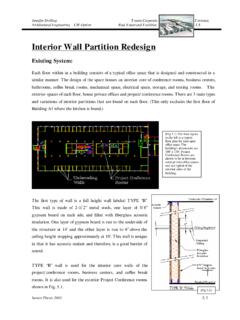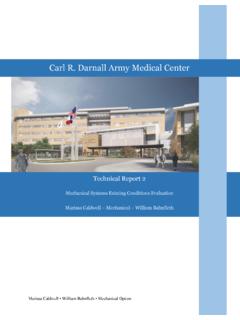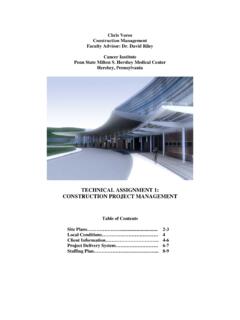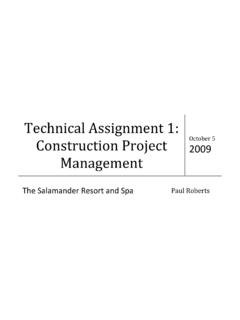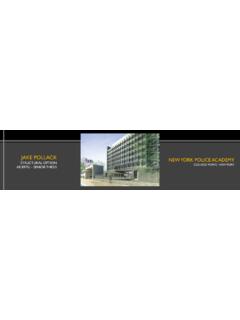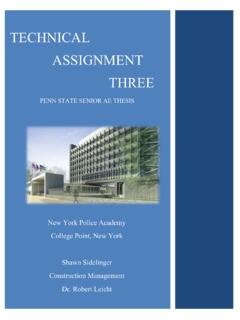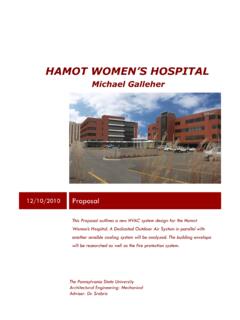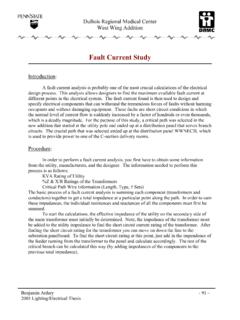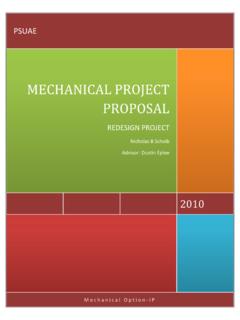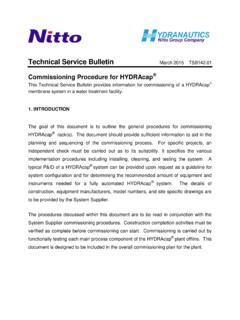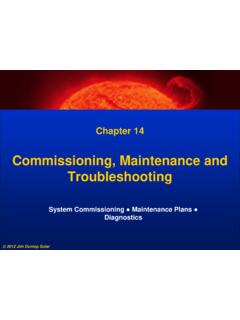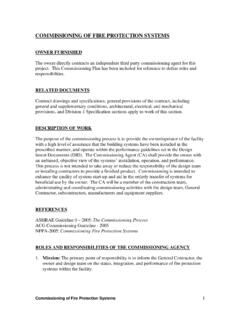Transcription of 6. Analysis #1- MEP Commissioning Process
1 Joseph A. Kifus Jr. Multi-Purpose Community Center Penn State University Fayette Campus PFC: Dr. Michael J. Horman, Penn State University 2004-2005 Senior Thesis Department of Architectural Engineering 426. Analysis #1- MEP Commissioning Process What is Commissioning ? Commissioning is a systematic Process of ensuring , verifying and documenting that a building facilities and systems performs in accordance with the design intent, contract documents, and the owner s operational needs.
2 Commissioning is a quality-assurance Process that is performed to increase the performance and likelihood that a newly constructed building and its systems meet the clients/owners expectations and needs. Types of Commissioning : Commissioning is the term used for the Cx of a new building. Re- Commissioning is the term used for Cx of a building that has been previously been commissioned. Retro- Commissioning is the term used for an existing building that has never previously been commissioned. Why Owners Need Building Commissioning (Benefits of): There are numerous benefits to Commissioning which are, but are not limited to: Maintain Construction Budget o Reduced change orders o Fewer cost overruns Insure the building will meet the Owners Design Intent Less contractor call-backs o Tests and verifies system which helps identifies future problems in the field.
3 Contractors are still available and on site Helps clarify and determine the appropriate course of action to take in order for proper MEP performance Provide Interdisciplinary Coordination between the Design Team, Contractors and Owners. Reduction in insurance claims. Most insurance claims have to do with the integrity of the buildings envelope-wall and roof leaks David Reid Senior VP and construction industry practice leader for national insurer, Marsh USA Inc. Prevents and resolves problems during the early stages of a project when cast are lower in additional cost to the owner Joseph A. Kifus Jr. Multi-Purpose Community Center Penn State University Fayette Campus PFC: Dr.
4 Michael J. Horman, Penn State University 2004-2005 Senior Thesis Department of Architectural Engineering 43 Shortens project duration o Expedites and clarify RFI s o Reviews design documents and specifications to perform them right the first time o Validates that the building systems perform as designed and specified Can support its designed usage/intent Improve the buildings design and functionality o Lower energy bills and reduced energy consumption o Improved indoor air quality and occupant comfort o Improved systems and equipment
5 Functions o Reduced energy and operations and maintenance costs o Proper operations o Maintenance training o Improved IAQ o Occupant comfort and productivity o Prevent inaccessibility of mechanical equipment Allows equipment accessibility for maintenance Long term tenant/owner satisfaction Complete project documentation Reduction in project delays Additional and easily obtainable LEED points Avoided costly equipment replacement/repairs o Reduces warrant and replacement and repair costs Basic Commissioning Process : Design Intent Basis of Design Develop Commissioning plan Design reviews Incorporate Commissioning into the specifications Develop Pre-functional checklist Construction review, coordination and inspection Schedule testing Perform test for system acceptance o Testing and verification Operations and Maintenance manuals System and building training Commissioning Report Warranty Review Joseph A.
6 Kifus Jr. Multi-Purpose Community Center Penn State University Fayette Campus PFC: Dr. Michael J. Horman, Penn State University 2004-2005 Senior Thesis Department of Architectural Engineering 44 Owner Hires CA Inc. Cx in Specs. Obtain Design Intent Develop Cx Plan Pre-functional Checklist Execute Checklist Approve Startup Deficiencies? Correct Deficiency Corrections Functional Test Direct & Witness Test Compliance? Approval Final Cx Report Typical Commissioning Plan Joseph A.
7 Kifus Jr. Multi-Purpose Community Center Penn State University Fayette Campus PFC: Dr. Michael J. Horman, Penn State University 2004-2005 Senior Thesis Department of Architectural Engineering Deficiencies Found in Non-Commissioned Buildings: Incorrect cooling and heating sequence of operation Incorrect calibration of sensors and instrumentation Disables systems and equipment IAQ issues Under-utilized computer based control systems Premature failure of HVAC equipment due to short cycling Malfunctioning air and water side economizer cycles Dirty filters and coils o Efficiency Lack of building documentation Missing or unspecified equipment Lack of training for building operators Cost Saving from Building Commissioning : Energy savings from 20 to 50 percent ($ to $ per sq.)
8 Ft.) Maintenance savings of 15 to 35 percent, typical. Reduced Claims of 2 to 10 percent Lower maintenance costs due to properly operating MEP equipment Elimination of additional overtime costs due to project deficiencies Why owners Commission their buildings: 81%80%53%41%37%25%0%10%20%30%40%50%60%70 %80%90%Ensuring systemperformancePotential EnergySavingsImprove ClientSatisfactionUtility FundingResearchImprove ComfortWhy Owners Cx Buildings *To ensure optimum system performance and the potential energy savings from doing so, is the main reason why owners are willing to commission their buildings as per a survey of owners who have commissioned their buildings since 1994.
9 Joseph A. Kifus Jr. Multi-Purpose Community Center Penn State University Fayette Campus PFC: Dr. Michael J. Horman, Penn State University 2004-2005 Senior Thesis Department of Architectural Engineering 46 Typical Cost Saving per Building Type/Usage: Building Type Cx Cost Annual Savings Simple Payback (yrs.) Facility Offices $24,000 $89,760 High Rise Buildings $12,745 $8,150 Medical Institutions $24,770 $65,535 Retail $12,800 $8,050 *Average Commissioning costs and savings along with payback based upon the most commonly Commissioned building types.
10 Commissioning historically has had a cost saving of 8-20% over non-commissioned buildings. General costs of Commissioning are relatively cheap, on the magnitude of % of the construction cost, which is a bargain in any owner s book given the added benefits listed above. MEP Commissioning is the focus, understandably, of numerous owners as it is one of the most complex and expensive systems in a building and is required to perform properly day in and day out for the life of the building. MEP Commissioning can include numerous subsystems. The "Iceberg Theory" recognizes national benchmarks which state only 20% of the building cost over the life of the building is in first cost.
